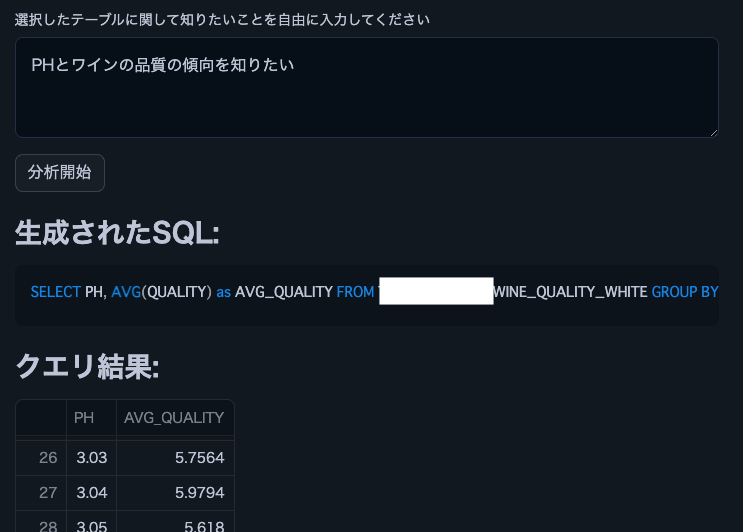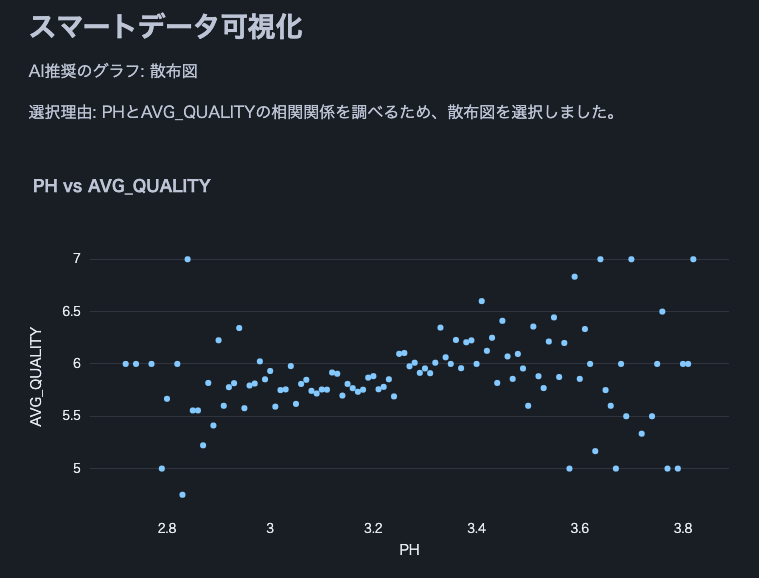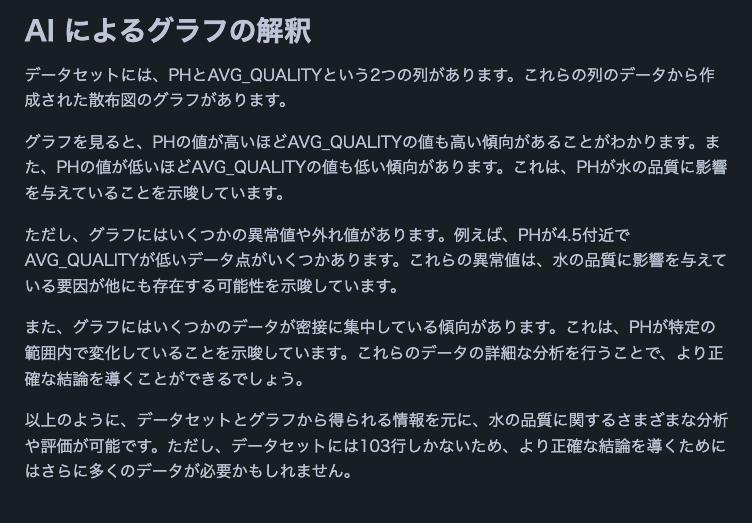Rumah >pembangunan bahagian belakang >Tutorial Python >Cuba analisis data bahasa semula jadi dengan Streamlit in Snowflake (SiS)
Cuba analisis data bahasa semula jadi dengan Streamlit in Snowflake (SiS)
- DDDasal
- 2024-09-14 12:15:30677semak imbas
pengenalan
Snowflake telah mengeluarkan ciri pembantu LLM yang dipanggil Snowflake Copilot sebagai ciri pratonton. Dengan Snowflake Copilot, anda boleh menganalisis data jadual menggunakan bahasa semula jadi.
Sebaliknya, Streamlit in Snowflake (SiS) membolehkan anda dengan mudah menggabungkan AI generatif dan mengakses data jadual dengan selamat. Ini membuatkan saya berfikir: bolehkah kita mencipta alat analisis data bahasa semula jadi yang lebih proaktif? Jadi, saya membangunkan apl yang boleh menganalisis dan menggambarkan data menggunakan bahasa semula jadi.
Nota: Catatan ini mewakili pandangan peribadi saya dan bukan pandangan Snowflake.
Gambaran Keseluruhan Ciri
Matlamat
- Boleh digunakan oleh pengguna perniagaan yang tidak biasa dengan SQL
- Keupayaan untuk memilih DB / skema / jadual melalui operasi tetikus untuk analisis
- Mampu menganalisis dengan pertanyaan bahasa semula jadi yang sangat samar-samar
Tangkapan Skrin Sebenar (Petikan)
Berikut adalah petikan daripada keputusan analisis menggunakan Cortex LLM (snowflake-arctic).



Nota: Kami menggunakan set data kualiti wain ini.
Senarai Ciri
- Pilih Cortex LLM untuk analisis
- Pilih DB / skema / jadual untuk analisis
- Paparkan maklumat lajur dan data sampel jadual yang dipilih
- Analisis menggunakan input bahasa semula jadi daripada pengguna
- Penjanaan SQL automatik untuk analisis
- Pelaksanaan automatik SQL yang dijana
- Paparan hasil pelaksanaan pertanyaan SQL
- Cerapan data disediakan oleh Cortex LLM
- Penggambaran data
- Pemilihan dan paparan graf yang sesuai oleh Cortex LLM
- Tafsiran data akhir oleh Cortex LLM
Keadaan Operasi
- Akaun Snowflake dengan akses kepada Cortex LLM
- snowflake-ml-python 1.1.2 atau lebih baru
Langkah berjaga-berjaga
- Berhati-hati apabila menggunakan set data yang besar kerana tiada had data ditetapkan
- Set hasil yang besar daripada pertanyaan SQL yang dijana mungkin mengambil masa untuk diproses
- Set hasil yang besar boleh menyebabkan ralat had token LLM
Kod Sumber
from snowflake.snowpark.context import get_active_session
import streamlit as st
from snowflake.cortex import Complete as CompleteText
import snowflake.snowpark.functions as F
import pandas as pd
import numpy as np
import json
import plotly.express as px
# Get current session
session = get_active_session()
# Application title
st.title("Natural Language Data Analysis App")
# Cortex LLM settings
st.sidebar.title("Cortex LLM Settings")
lang_model = st.sidebar.radio("Select the language model you want to use",
("snowflake-arctic", "reka-flash", "reka-core",
"mistral-large2", "mistral-large", "mixtral-8x7b", "mistral-7b",
"llama3.1-405b", "llama3.1-70b", "llama3.1-8b",
"llama3-70b", "llama3-8b", "llama2-70b-chat",
"jamba-instruct", "gemma-7b")
)
# Function to escape column names
def escape_column_name(name):
return f'"{name}"'
# Function to get table information
def get_table_info(database, schema, table):
# Get column information
columns = session.sql(f"DESCRIBE TABLE {database}.{schema}.{table}").collect()
# Create DataFrame
column_df = pd.DataFrame(columns)
# Get row count
row_count = session.sql(f"SELECT COUNT(*) as count FROM {database}.{schema}.{table}").collect()[0]['COUNT']
# Get sample data
sample_data = session.sql(f"SELECT * FROM {database}.{schema}.{table} LIMIT 5").collect()
sample_df = pd.DataFrame(sample_data)
return column_df, row_count, sample_df
# Data analysis function
def analyze(df, query):
st.subheader("Result Analysis")
# Display basic statistical information
st.subheader("Basic Statistics")
st.write(df.describe())
# Use AI for data analysis
analysis_prompt = f"""
Based on the following dataframe and original question, please perform data analysis.
Concisely explain in English the insights, trends, and anomalies derived from the data.
If possible, please also mention the following points:
1. Data distribution and characteristics
2. Presence of abnormal values or outliers
3. Correlations between columns (if there are multiple numeric columns)
4. Time-series trends (if there is date or time data)
5. Category-specific features (if data can be divided by categories)
Dataframe:
{df.to_string()}
Original question:
{query}
"""
analysis = CompleteText(lang_model, analysis_prompt)
st.write(analysis)
# Data visualization function
def smart_data_visualization(df):
st.subheader("Smart Data Visualization")
if df.empty:
st.warning("The dataframe is empty. There is no data to visualize.")
return
# Request AI for graph suggestion
columns_info = "\n".join([f"{col} - type: {df[col].dtype}" for col in df.columns])
sample_data = df.head().to_string()
visualization_prompt = f"""
Analyze the information of the following dataframe and suggest the most appropriate graph type and the columns to use for its x-axis and y-axis.
Consider the characteristics of the data to ensure a meaningful visualization.
Column information:
{columns_info}
Sample data:
{sample_data}
Please provide only the following JSON data format as your response:
{{
"graph_type": "One of: scatter plot, bar chart, line chart, histogram, box plot",
"x_axis": "Column name to use for x-axis",
"y_axis": "Column name to use for y-axis (if applicable)",
"explanation": "Brief explanation of the selection reason"
}}
"""
ai_suggestion = CompleteText(lang_model, visualization_prompt)
try:
suggestion = json.loads(ai_suggestion)
graph_type = suggestion['graph_type']
x_axis = suggestion['x_axis']
y_axis = suggestion.get('y_axis') # y-axis might not be needed in some cases
explanation = suggestion['explanation']
st.write(f"AI recommended graph: {graph_type}")
st.write(f"Selection reason: {explanation}")
if graph_type == "scatter plot":
fig = px.scatter(df, x=x_axis, y=y_axis, title=f"{x_axis} vs {y_axis}")
elif graph_type == "bar chart":
fig = px.bar(df, x=x_axis, y=y_axis, title=f"{y_axis} by {x_axis}")
elif graph_type == "line chart":
fig = px.line(df, x=x_axis, y=y_axis, title=f"{y_axis} over {x_axis}")
elif graph_type == "histogram":
fig = px.histogram(df, x=x_axis, title=f"Distribution of {x_axis}")
elif graph_type == "box plot":
fig = px.box(df, x=x_axis, y=y_axis, title=f"Distribution of {y_axis} by {x_axis}")
else:
st.warning(f"Unsupported graph type: {graph_type}")
return
st.plotly_chart(fig)
except json.JSONDecodeError:
st.error("Failed to parse AI suggestion. Please try again.")
except KeyError as e:
st.error(f"AI suggestion is missing necessary information: {str(e)}")
except Exception as e:
st.error(f"An error occurred while creating the graph: {str(e)}")
# AI interpretation of visualization
visualization_interpretation_prompt = f"""
Based on the following dataset and created graph, please provide a detailed interpretation of the data trends and characteristics in English.
Point out possible insights, patterns, anomalies, or areas that require additional analysis.
Dataset information:
Columns: {', '.join(df.columns)}
Number of rows: {len(df)}
Created graph:
Type: {graph_type}
X-axis: {x_axis}
Y-axis: {y_axis if y_axis else 'None'}
"""
ai_interpretation = CompleteText(lang_model, visualization_interpretation_prompt)
st.subheader("AI Interpretation of the Graph")
st.write(ai_interpretation)
# Function to handle cases where AI response is not just SQL query
def clean_sql_query(query):
# Remove leading and trailing whitespace
query = query.strip()
# If not starting with SQL keywords, remove everything up to the first SELECT
if not query.upper().startswith(('SELECT')):
keywords = ['SELECT']
for keyword in keywords:
if keyword in query.upper():
query = query[query.upper().index(keyword):]
break
return query
# Function for natural language querying of DB
def data_analysis_and_natural_language_query():
# Database selection
databases = session.sql("SHOW DATABASES").collect()
database_names = [row['name'] for row in databases]
selected_database = st.selectbox("Select a database", database_names)
if selected_database:
# Schema selection
schemas = session.sql(f"SHOW SCHEMAS IN DATABASE {selected_database}").collect()
schema_names = [row['name'] for row in schemas]
selected_schema = st.selectbox("Select a schema", schema_names)
if selected_schema:
# Table selection
tables = session.sql(f"SHOW TABLES IN {selected_database}.{selected_schema}").collect()
table_names = [row['name'] for row in tables]
selected_table = st.selectbox("Select a table", table_names)
if selected_table:
# Get table information
column_df, row_count, sample_df = get_table_info(selected_database, selected_schema, selected_table)
st.subheader("Table Information")
st.write(f"Table name: `{selected_database}.{selected_schema}.{selected_table}`")
st.write(f"Total rows: **{row_count:,}**")
st.subheader("Column Information")
st.dataframe(column_df)
st.subheader("Sample Data (showing only 5 rows)")
st.dataframe(sample_df)
# Stringify table information (for AI)
table_info = f"""
Table name: {selected_database}.{selected_schema}.{selected_table}
Total rows: {row_count}
Column information:
{column_df.to_string(index=False)}
Sample data:
{sample_df.to_string(index=False)}
"""
# Natural language input from user
user_query = st.text_area("Enter what you want to know about the selected table")
if st.button("Start Analysis"):
if user_query:
# Use AI to generate SQL
prompt = f"""
Based on the following table information and question, please generate an appropriate SQL query.
Return only the generated SQL query without any additional response.
Table information:
{table_info}
Question: {user_query}
Notes:
- Follow Snowflake SQL syntax.
- Use aggregate functions to keep the query result size manageable.
- Use {selected_database}.{selected_schema}.{selected_table} as the table name.
"""
generated_sql = CompleteText(lang_model, prompt)
generated_sql = clean_sql_query(generated_sql)
st.subheader("Generated SQL:")
st.code(generated_sql, language='sql')
try:
# Execute the generated SQL
result = session.sql(generated_sql).collect()
df = pd.DataFrame(result)
st.subheader("Query Result:")
st.dataframe(df)
# Analyze results
analyze(df, user_query)
# Smart data visualization
smart_data_visualization(df)
except Exception as e:
st.error(f"An error occurred while executing the query: {str(e)}")
else:
st.warning("Please enter a question.")
# Execution part
data_analysis_and_natural_language_query()
Kesimpulan
Keupayaan untuk menganalisis data jadual dengan mudah menggunakan bahasa semula jadi tanpa pengetahuan SQL atau Python boleh meluaskan skop penggunaan data dengan ketara dalam perusahaan untuk pengguna perniagaan. Dengan menambahkan ciri seperti menyertai berbilang jadual atau meningkatkan kepelbagaian graf visualisasi, analisis yang lebih kompleks boleh dilakukan. Saya menggalakkan semua orang cuba melaksanakan pendemokrasian analisis data menggunakan Streamlit in Snowflake.
Pengumuman
Kepingan Salji Apakah Kemas Kini Baharu pada X
Saya berkongsi kemas kini Snowflake's What's New pada X. Sila ikuti jika anda berminat!
Versi Bahasa Inggeris
Snowflake What's New Bot (Versi Bahasa Inggeris)
https://x.com/snow_new_en
Versi Jepun
Bot Baharu Kepingan Salji (Versi Jepun)
https://x.com/snow_new_jp
Sejarah Perubahan
(20240914) Catatan awal
Artikel Asal Jepun
https://zenn.dev/tsubasa_tech/articles/2608c820294860
Atas ialah kandungan terperinci Cuba analisis data bahasa semula jadi dengan Streamlit in Snowflake (SiS). Untuk maklumat lanjut, sila ikut artikel berkaitan lain di laman web China PHP!

